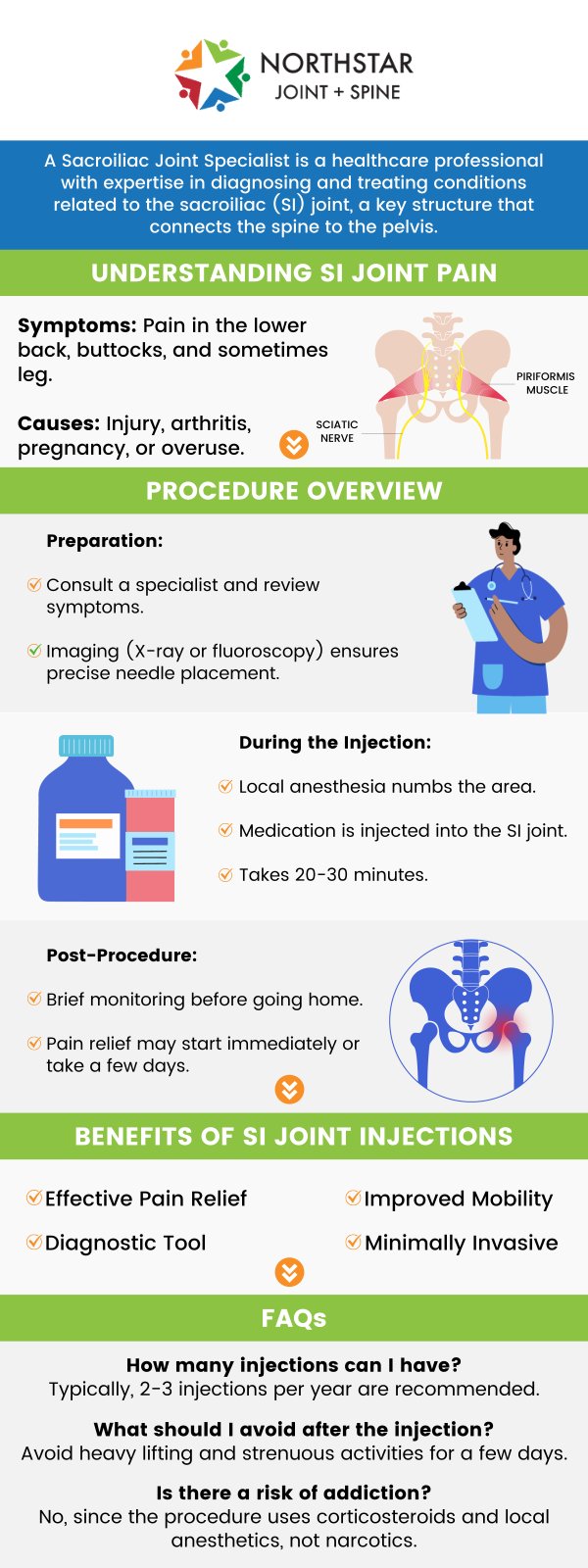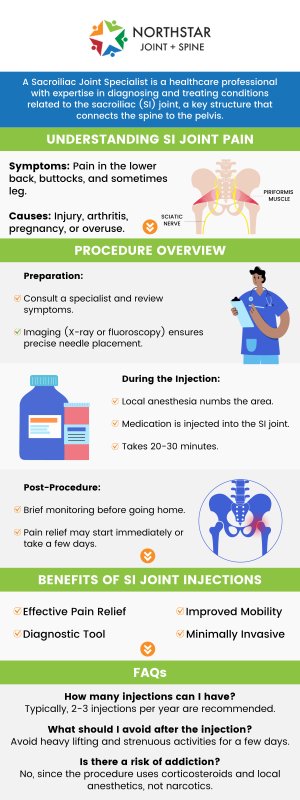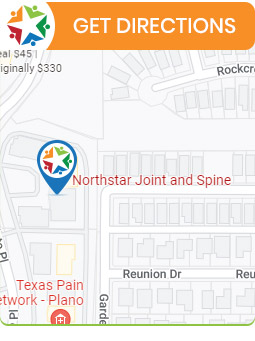Sacroiliac Joint Pain Treatment Specialist in Plano, TX
Sacroiliac joint pain is caused by inflammation or dysfunction of the sacroiliac joint, located where the spine meets the pelvis. This pain often manifests as lower back, buttock, or hip discomfort that can be sharp or dull. At Northstar Joint and Spine, Board Certified Dr. Robert J. Nocerini, MD, provides professional diagnosis and treatment to relieve symptoms and restore mobility. For more information, please contact us today or schedule an appointment online. We are conveniently located at 7704 San Jacinto Pl Suite #200 Plano, TX 75024.


Table of Contents:
What is sacroiliac joint pain?
What causes sacroiliac joint pain?
What are the symptoms of sacroiliac joint pain?
When should I seek medical attention for sacroiliac joint pain?
How Does Dr. Robert Nocerini Treat Sacroiliac Joint Pain at Northstar Joint and Spine in Plano, TX?
Sacroiliac joint pain is a type of pain that centers around the connection point between the spine and pelvis, where the sacrum meets the ilium on each side of the lower back. When that joint becomes irritated or inflamed, it can lead to stiffness and discomfort that tends to feel deeper and more persistent than general muscle soreness. While it sits just beneath the surface of the lower back, the pain often spreads outward toward the hips or into the upper thigh, depending on how one side of the joint is affected compared to the other. Because this joint plays a major role in how the upper body transfers force through the legs, even minor cases of irritation there can create significant discomfort with walking, standing, or climbing stairs. The pain may be sharp and sudden with movement, or more of a low-level ache that lingers throughout the day. It tends to worsen with certain activities that put uneven strain on the pelvis, particularly if the joint isn’t moving smoothly the way it should.
Sacroiliac joint pain usually shows up when the joint becomes overly stiff or excessively mobile, throwing off the normal balance between the spine and pelvis. Repetitive stress on one side of the body, muscle imbalances, or underlying inflammation in the area can all contribute to the discomfort. In some cases, shifts in posture or long periods of standing unevenly can increase pressure on one of the joints, leading to irritation over time.
The sacroiliac joint isn’t designed for a wide range of motion, so when that stability is compromised, it can disrupt the way force moves through the lower back and hips. Over time, that imbalance can build into a nagging ache or produce sharp, localized pain with motion. If the surrounding muscles begin to tighten or overcompensate, it can make the discomfort more pronounced and harder to shake off with rest alone.
Discomfort tied to the sacroiliac joint typically presents in the lower back, just above the tailbone, and may extend outward into the hip or upper thigh. Some may experience sacroiliac joint pain as a stabbing sensation with certain movements, while others notice more of a dull, pulling ache that seems to stick around throughout the day. It often worsens with climbing stairs, turning over in bed, or rising from a seated position, especially when one side of the pelvis is doing more of the work than the other. Another common symptom is stiffness or a feeling that the lower back is locked up, particularly after sitting or lying down for long stretches. Some individuals also report a kind of instability in the pelvis, like the joint isn’t moving in sync with the rest of the spine. That lack of coordination can make even simple movements uncomfortable if the joint continues to stay inflamed and the surrounding muscles stay on edge.
When sacroiliac joint pain doesn’t ease up with time or starts affecting balance and mobility, it’s usually a sign that the joint isn’t settling on its own. If the pain consistently worsens with certain motions, spreads down into the legs, or causes a feeling of catching or instability, then a more in-depth evaluation may be needed to determine whether the joint is moving properly or if there’s irritation along the supporting structures.
The specialists at Northstar Joint and Spine can help determine whether the sacroiliac joint is the source of the issue through physical assessment and targeted diagnostic tools. When conservative measures like stretching or posture correction aren’t enough to reduce the discomfort, there are more precise ways to address inflammation in the area and restore stability to that part of the spine. Patients should not hesitate to seek specialized care, as when the issue is identified early, it can help prevent the surrounding muscles from overworking and turning the pain into a more widespread or chronic problem.
Board-Certified Dr. Robert Nocerini, MD at Northstar Joint and Spine in Plano, TX, specializes in providing advanced, non-surgical treatments for sacroiliac joint pain. He focuses on identifying the root cause of discomfort and delivering targeted therapies that help reduce inflammation and stabilize the joint. Through precision-guided procedures and personalized treatment plans, Dr. Nocerini helps patients experience significant and lasting relief.
At his Plano clinic, Dr. Nocerini blends modern interventional techniques with compassionate, results-driven care. His treatments may include diagnostic nerve blocks, physical therapy guidance, or radiofrequency ablation to manage pain effectively. Patients appreciate his focus on restoring movement, improving posture, and helping them return to their daily activities with renewed comfort and confidence.
Sacroiliac joint pain treatment is available at Northstar Joint and Spine. For more information, please contact us today or schedule an appointment online. We are conveniently located at 7704 San Jacinto Pl Suite #200 Plano, TX 75024. We serve patients from Plano TX, Willow Bend TX, Frisco TX, Allen TX, Addison TX, North Dallas TX, and surrounding areas.

Check Out Our 5 Star Reviews


Additional Services You May Need
▸ Back Pain
▸ Chronic Pain
▸ Epidural Steroid Injections
▸ Spinal Cord Stimulation
▸ Viscosupplementation
▸ Genicular Nerve Blocks
▸ Facet Injections
▸ Joint Injections
▸ Sacroiliac Joint Injections
▸ Lumbar and Cervical
▸ Facet Medial Branch Blocks
▸ Diagnostic Nerve Blocks
▸ Medication Management
▸ Neck Pain Doctor
▸ Diabetic Peripheral Neuropathy
▸ Headaches
▸ Suboxone
▸ Botox for Migraines
▸ Peripheral Nerve Stimulation
▸ Spine
▸ Joints
▸ Muscles
▸ Bones

Additional Services You May Need
▸ Back Pain
▸ Chronic Pain
▸ Epidural Steroid Injections
▸ Spinal Cord Stimulation
▸ Viscosupplementation
▸ Genicular Nerve Blocks
▸ Facet Injections
▸ Joint Injections
▸ Sacroiliac Joint Injections
▸ Lumbar and Cervical
▸ Facet Medial Branch Blocks
▸ Diagnostic Nerve Blocks
▸ Medication Management
▸ Neck Pain Doctor
▸ Diabetic Peripheral Neuropathy
▸ Headaches
▸ Suboxone
▸ Botox for Migraines
▸ Peripheral Nerve Stimulation
▸ Spine
▸ Joints
▸ Muscles
▸ Bones






